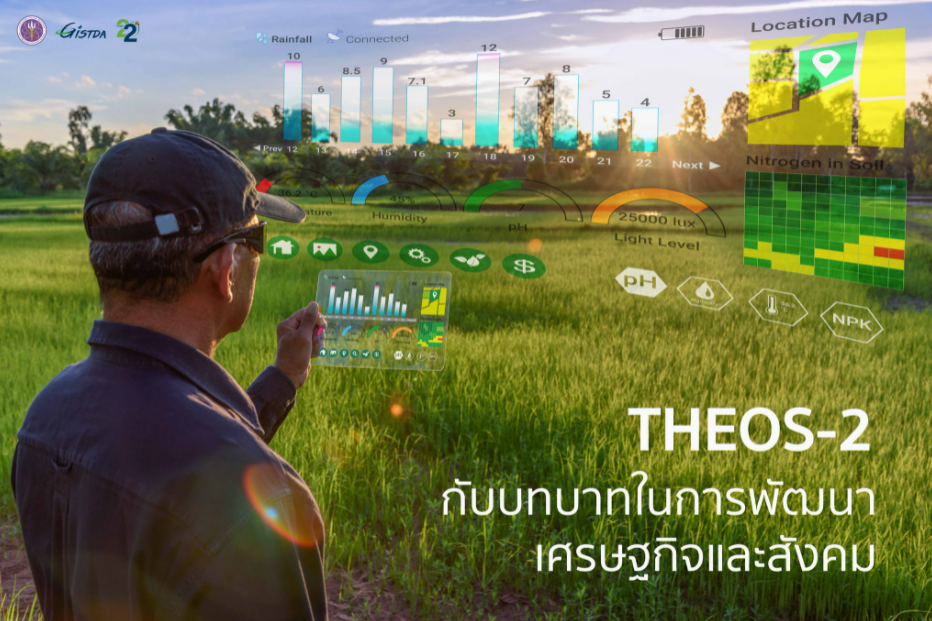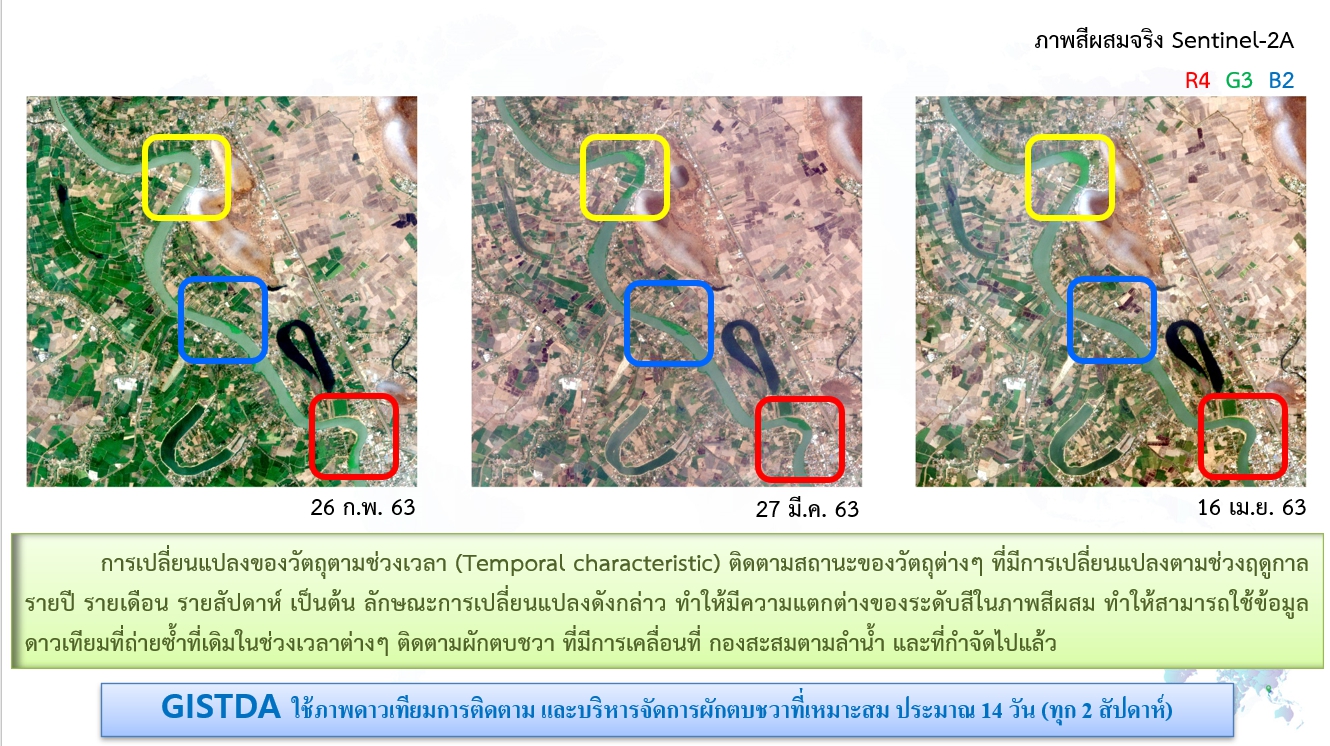Energy Interactions in Atmosphere
Electromagnetic wave travels through atmosphere; then reflects to the atmosphere before being detected by sensing tools. Global atmosphere causes changes of energy waves in terms of direction, darkness, including length and frequency of waves because the atmosphere consists of dust, steam and gazes, which cause reaction with energy wave in three processes: scattering, absorption and refraction. Therefore, there is less amount of incident energy on earth surface.
Scattering occurs due to small particles in the atmosphere that uncertainly scatter depending on particle size and wavelength. There are three types of scattering as follows:
1. Rayleigh scattering takes place because the diameter of particles is smaller than reflected wavelength, which causes haze. It affects a decrease of low resolution of photo.
2. Mie scattering happens when the particle size is similar to wavelength but longer than particles in Rayleigh scattering such as steam and dust.
3. Nonselective scattering occurs when the diameter of particles is longer than reflected wavelength such as drop or cloud. In general, the length of particles is at 5-10 micrometers. It can reflect visual wavelength as same as reflected infrared. In the bands, blue, green and red can be visible and in reflected wave, it can see white cloud in all directions.
Absorption cause the loss of energy. It occurs at some span of wavelength in the atmosphere. The absorbing substances are steam, carbon dioxide and ozone because these substances absorb specific-wavelength energy. Therefore, in some spans it penetrates through atmosphere to earth surface called Atmospheric Window as shown in Figure 3.5, in which there are atmospheric window with visual wavelength (0.3-0.7 micrometer), reflected infrared and thermal infrared. The atmospheric window spans are useful for selection and development of sensing tools interacting with reflection of wavelengths.
Refraction occurs when light travels through atmosphere having unequal density. The quantity of refraction depends on refraction index, ratio between light speed in space and atmosphere, which causes the light change. It influences on deviation of appearing photo position, but it can be adjusted through photo adjustment process.
Energy interactions with earth surface features
When the electromagnetic energy travelling through atmosphere incident the earth surface, there will be three interactions: reflection, absorption and transmission, which are crucial phenomena in remote sensing of materials on earth surface. It can be described in the following equation, Energy Balance Equation:
EI (λ) = ER (λ) + EA (λ) + ET (λ)
EI (λ) = Incident energy at wavelength λ
ER (λ) = Reflected energy at wavelength λ
EA (λ) = Absorption energy at wavelength λ
ET (λ) = Transmission energy at wavelength λ
Ratios of absorption, transmission and reflection of energy are different depending on types of substances; as a result, the substances in photos can then be categorized. Moreover, the same materials have different interactions based on reflected wavelength. Two materials may not be different in a particular wavelength, but it can be separated in another wavelength. In the visual wave span, differences towards materials’ ray wave are shown in form of different colors; for example, we can see green materials since the materials reflect energy in green wave span.
Because most energy recording systems records reflected energy, the study of material categorization is then the study of energy reflection of materials, which can be transferred into the equation: EI (λ) = ER (λ) + EA (λ) + ET (λ), “Reflected energy equals incident energy minus the sum of absorption energy and transmission energy.”
Characteristics of material surface are important since it influences on energy of material that has flat surface and reflection angle is as same as incidence angle. It is called Specular Reflectors. While rough-surface materials have disordered energy reflection called Diffuse Reflection or Lambertian Reflection. However, most materials’ characteristics are mixed between these two mentioned characteristics.
Not only surface characteristics must be recognized, but also length of incident wave must be emphasized. The short-wavelength energy comparing with particle size of material compiling to be material surface or asymmetric surface of material probably reflects the light to rough-surface materials. If the same material gets incident energy in long wavelength, light reflection likely reflects to flat-surface material if comparing with material surface.
Remote sensing is a measurement of energy reflection ratio of material on the earth surface at a particular wavelength called Spectral Reflectance from the following equation:
ρλ = Eλ (λ) / EI (λ)
ρλ = Spectral Reflectance at wavelength λ
It usually indicates in ratio or percentage between reflection energy and incident energy. The energy measured by sensing tools therefore consists of energy reflecting or radiating from material surface. Some energy is from interactions in the atmosphere or energy that directly reflects from the cloud. The value of measurement depends on conditions of atmosphere, angle of the sun, location of sensing tools, characteristics of materials towards energy reflection, absorption and transmission.
Spectral reflectance of vegetation, soil and water
Vegetation, soil and water are mostly materials covering the earth surface. Energy reflection with different wavelength of vegetation, soil and water helps to divide types of materials. These three types of materials has its own specific interaction to wavelength called Spectral Signature with the same wavelength. Different type of materials also has different energy reflection. If length of wavelength is different, the same type of materials will reflect different spectral reflectance Moreover, different length of wavelength causes spectral reflectance of materials, so it is likely to categorize materials’ categories.
Vegetation
At the visual wavelength, chlorophyll of plants’ leaves absorb blue energy (0.4-0.5 micrometers) and red energy (0.6-0.7 micrometer), but it reflects green energy (0.5-0.6 micrometer). Human’s eyes can therefore see green plants. If the leaves are abnormal such as dry or wither, it causes decrease of chlorophyll, which increases the red wave reflection in infrared wavelength reflection (0.7-1.3 micrometers). Degree of energy reflection of plants’ leaves is really high, that is, it reflects energy at approximately 50 percent of incident energy. It is continuous reflection from its cell structure because different internal structure of vegetation helps separate types of it. Accordingly, energy reflection can separate types of vegetation although energy reflection of vegetation in visual wavelength is similar. Similarly, the vegetation’s energy reflection of infrared wavelength is abnormal, there will be differences comparing with the normal vegetation. Therefore, remote sensing system can record wavelength reflection values, and it can be used for observing abnormality of vegetation in wavelength that is longer than 1.3 micrometers. Most energy is much less absorbed or reflected at 1.4, 1.9 and 2.7 micrometers because in this band the water in vegetation will absorb energy called Water Absorption Bands. Therefore, energy reflection values of vegetation is also inverted with quantity of water in plants’ leaves.
Soil
Relationship between energy reflection of soil and small fluctuated wavelength. Major factors influencing on energy reflection of soil are soil humidity, amount of organic objects, soil texture, and amount of oxide and fluctuation of ground soil. These factors are complex and relate to each other; for example, characteristics of ground soil has relationship with quantity of water in soil, rough sandy soil that can drain well reflects large amount of energy, tender soil drains badly and reflects small amount of energy, soil with high degree of organic matters has dark color, absorbs a lot of energy in visual band as same as soil with big amount of oxide also has dark color as energy reflection decreases and ground soil is more rough, which influence on the decrease of energy reflection.
Water
In general, water can absorb energy; however, there are several types of water causing different energy absorption. Energy reflection of water is obviously different from other objects, especially infrared. Water completely absorbs energy that can help to fix water boundary since there are several conditions of water on earth surface such as turbid water, clear water, and mixed-suspension water. The energy reflection is therefore different. The space for water sometimes influences on water energy reflection. Clear water absorbs small amount of energy at lower 0.6 micrometer band. Energy transmission highly happens at blue and green bands while water consisting of suspended sediment or impurities causes the change of energy reflection and transmission; for example, water with large amount of suspended sediment can reflect energy more than clear water, more chlorophyll in water affects the decrease of blue band reflection but increase of green band refection, which is useful for follow-up and seaweed quantity prediction. Moreover, data towards energy reflection is also useful for oil slip inspection and industrial pollution.
ที่มา : ตำราเทคโนโลยีอวกาศและภูมิสารสนเทศศาสตร์



